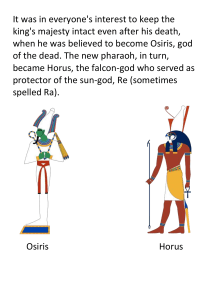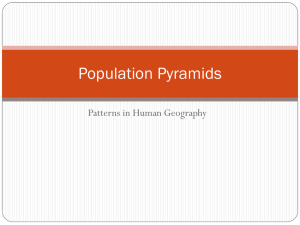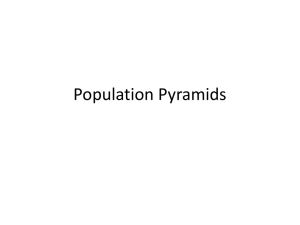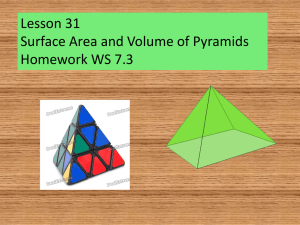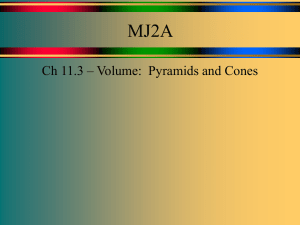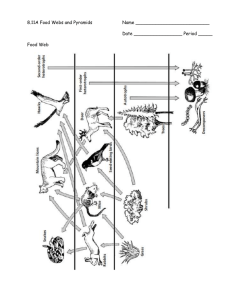Activity 6.3.6 The Volume Formula for Pyramids
advertisement
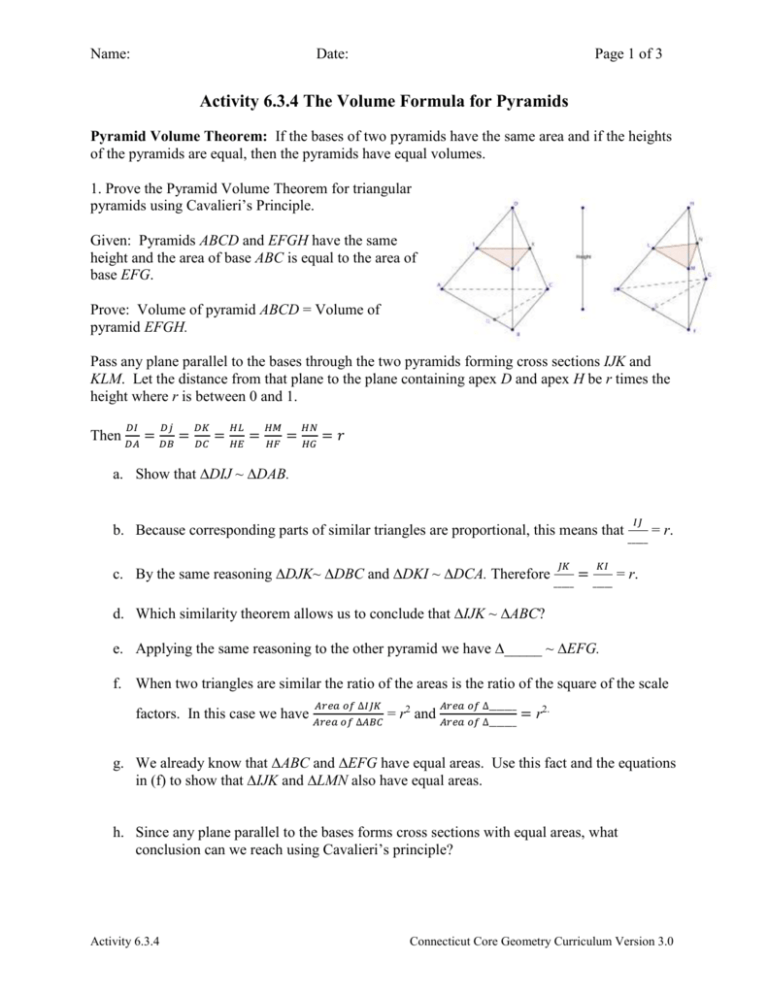
Name: Date: Page 1 of 3 Activity 6.3.4 The Volume Formula for Pyramids Pyramid Volume Theorem: If the bases of two pyramids have the same area and if the heights of the pyramids are equal, then the pyramids have equal volumes. 1. Prove the Pyramid Volume Theorem for triangular pyramids using Cavalieri’s Principle. Given: Pyramids ABCD and EFGH have the same height and the area of base ABC is equal to the area of base EFG. Prove: Volume of pyramid ABCD = Volume of pyramid EFGH. Pass any plane parallel to the bases through the two pyramids forming cross sections IJK and KLM. Let the distance from that plane to the plane containing apex D and apex H be r times the height where r is between 0 and 1. 𝐷𝐼 𝐷𝑗 Then 𝐷𝐴 = 𝐷𝐵 = 𝐷𝐾 𝐷𝐶 𝐻𝐿 = 𝐻𝐸 = 𝐻𝑀 𝐻𝐹 𝐻𝑁 = 𝐻𝐺 = 𝑟 a. Show that ∆DIJ ~ ∆DAB. 𝐼𝐽 b. Because corresponding parts of similar triangles are proportional, this means that _____ = r. 𝐽𝐾 𝐾𝐼 c. By the same reasoning ∆DJK~ ∆DBC and ∆DKI ~ ∆DCA. Therefore _____ = _____ = r. d. Which similarity theorem allows us to conclude that ∆IJK ~ ∆ABC? e. Applying the same reasoning to the other pyramid we have ∆_____ ~ ∆EFG. f. When two triangles are similar the ratio of the areas is the ratio of the square of the scale 𝐴𝑟𝑒𝑎 𝑜𝑓 ∆𝐼𝐽𝐾 𝐴𝑟𝑒𝑎 𝑜𝑓 ∆_______ factors. In this case we have 𝐴𝑟𝑒𝑎 𝑜𝑓 ∆𝐴𝐵𝐶 = r2 and 𝐴𝑟𝑒𝑎 𝑜𝑓 ∆_______ = r2. g. We already know that ∆ABC and ∆EFG have equal areas. Use this fact and the equations in (f) to show that ∆IJK and ∆LMN also have equal areas. h. Since any plane parallel to the bases forms cross sections with equal areas, what conclusion can we reach using Cavalieri’s principle? Activity 6.3.4 Connecticut Core Geometry Curriculum Version 3.0 Name: Date: Page 2 of 3 Pyramid-Prism Theorem: The volume of a pyramid is one-third the volume of a prism with the same base and height. To help prove this theorem we will build a model of a prism that encloses three pyramids of equal volume. Work in groups of four. 2. Have each member of your four-person group build one of the models on the Activity 6.4.1 Template. A. The original pyramid: ∆ABC is yellow, ∆CBD is green. B. The prism “box”. ∆ABC is yellow and ∆DEF is yellow. Note that ∆DEF has no tabs. This is so it can be opened and closed like the top of a box. C. A second pyramid. ∆ DEF is yellow, ∆ DBE is purple. D. A third pyramid. This pyramid is in the interior of the prism. ∆ DCB is green, ∆ DEB is purple. 3. To account for the thickness of the card stock, the prism is just ever so slightly larger in scale than the rest of the parts. This makes it possible to put the three pyramids inside the box. Use the color-coding purple face to purple face and green face to green face to help you fit the pyramids inside the prism. Could you get them to fit? 4. Have each member of the team measure one of the models and calculate its volumes using the formulas that we encountered informally at the beginning of the unit. Show the work on your model here: 5. Use your group’s calculations to complete the table below: Shape Prism Pyramid 1 Pyramid 2 Pyramid 3 Calculated Volume 6. Since you have used measurements to find the volumes in question 5 your volumes will be approximate. Taking that into account, what patterns do you notice in your table? Activity 6.3.4 Connecticut Core Geometry Curriculum Version 3.0 Name: Date: Page 3 of 3 7. Now we will be more precise in our reasoning. Consider the two pyramids with yellow bases. From their position in the prism we notice that they both have the same base as the prism and they have the same altitude as the prism. What can we conclude about their volumes using the Pyramid Volume Theorem? 8. Now take one of the pyramids with a yellow base and the pyramid that has purple and green faces. These two pyramids will have either congruent purple or green faces. Arrange them so that they are placed on the table on their congruent faces. a. What do you notice about the heights of these pyramids? b. What does this tell you about their volumes? Explain. 9. So now we have three pyramids with the same volume. And we have a prism that contains all three of the pyramids. What is the relationship between the volume of each of the pyramids and the volume of the prism? 10. Write a formula for the volume of a pyramid. Activity 6.3.4 Connecticut Core Geometry Curriculum Version 3.0

